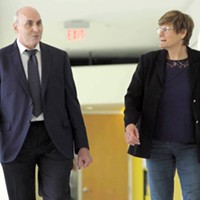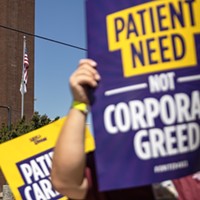Saving Each Other
Each of us can save lives. Right now.
By Jennifer Fumiko Cahill [email protected] @jfumikocahill and Thadeus Greenson [email protected] @ThadeusGreenson[
{
"name": "Top Stories Video Pair",
"insertPoint": "7",
"component": "17087298",
"parentWrapperClass": "fdn-ads-inline-content-block",
"requiredCountToDisplay": "1"
}
]
It's no stretch to say that we in Humboldt County — and the rest of the country — stand on the precipice, facing the very real threat of widespread death and suffering. New York City is already there. But it's also no stretch to say — at this moment in Humboldt County, anyway — we individually and collectively retain some control over how this plays out. Never before in our history have the actions of each of us been so crucial to our collective well being, so never before has it been so imperative that we put community ahead of ourselves.
If that seems hyperbolic, consider a few things:
A contact study in South Korea found that a single COVID-19 patient was potentially responsible for infecting some 1,100 others with the virus because she carried on with life as normal — attending church services and hotel buffets — after experiencing symptoms. We cannot know how many others those 1,100 people may then have infected.
Other studies have shown that some 25 percent of COVID-19 cases never experience symptoms, meaning if they simply carry on with their daily lives because they feel fine, they will spend at least 14 days shedding the virus, releasing virtual clouds of it in aerosols wherever they go and leaving it to live on surfaces for up to three days.
Andy Slavitt, former acting administrator for the Centers for Medicare and Medicaid Services and a senior advisor to the Bipartisan Policy Center, estimates that one person can be directly responsible for 40 deaths if they fail to take proper precautions, like sheltering in place and wearing a face covering.
It's also very important for us in Humboldt County to recognize that we are in an especially precarious position, with a local healthcare system that is strained in the best of times, much less under the threat of a pandemic. As everyone in local government also knows, rural California can easily find itself in the back of the line for federal and state assistance. The hard truth is we may find ourselves on our own, especially if we hasten the worst this virus threatens to bring.
This week we reported that a group of generous people and entities combined to donate a dozen ventilators to St. Joseph Hospital. Those machines will provide a roughly 50-percent increase to countywide ventilator capacity when they arrive sometime next month. That's good news. But let's also put it into the context of the bad.
In the week from March 30 to April 6, Humboldt County saw its COVID-19 caseload more than double from 21 to 49. If that rate holds, we'll see 114 cases on April 13, 266 cases by April 20, 622 cases by April 27, 1,451 cases by May 4 and 3,388 cases by May 11, around the time those extra ventilators are expected to roll into town.
The reason those ventilators are so important is that there is no cure for the COVID-19 disease. Ventilators allow healthcare workers to keep seriously ill patients on them for life support, hopefully buying enough time — often a week or two — for their bodies to fight off the disease. In Wuhan, China, about 5 percent of COVID-19 patients fell critically ill — a designation that generally necessitates intensive care, intubation and the help of a ventilator — for a chance at survival.
If we in Humboldt County find ourselves with 3,389 cases by May 11 and 5 percent are critically ill, that's 169 people. Doctors would be left with the brutal task of figuring out who among those patients gets access to those 36 or so potentially life-saving ventilators.
We don't have to end up there. The great news for Humboldt County is that while that may be the road we are on, there's still hope. But it will take all of us treating COVID-19 like the deadly threat it is by doing whatever we can to make sure we're protecting our neighbors and healthcare workers.
That means staying home and planning ahead to limit essential outings. If you can manage only going to the store every two or three weeks, do it. Limit outdoor recreation to areas around your home and always maintain the imperative minimum 6 feet of social distance. When you must go out, wear a facial covering — not to protect yourself but to make sure that if you turn out to be among the 25 percent of people who have the virus without showing symptoms, you're not spreading it to others. (And if you for some reason have the highly coveted surgical or N95 masks at home, please donate them. Healthcare workers desperately need them. A bandana, scarf or other homemade alternative is good enough to help keep you from spreading the virus.)
Make no mistake, this is poised to get dark in a hurry. And if it does, there will be shame and regret. The bell is ringing but there's still time to answer it. Our neighbors' lives rest in our hands. Let's save them.
Speaking of...
Comments (2)
Showing 1-2 of 2
More by Jennifer Fumiko Cahill
-
What's Good
New Digs for Il Forno and Obento
- Jul 11, 2024
-
Maxxxine's Bloody Point
- Jul 11, 2024
-
Il Forno in Fortuna
- Jul 8, 2024
- More »
More by Thadeus Greenson
-
'Inadvertent Disclosure'
Eureka City Schools emails shed light on Jacobs property swap
- Jul 25, 2024
-
Jackson's Retreat
The contract clause that allowed Cal Poly Humboldt's embattled president to step down into a high-paid instructional position
- Jul 25, 2024
-
'Profound Concern'
Alleged victim distressed by DA's handling of hate speech, antisemitic threats case
- Jul 25, 2024
- More »
Latest in Editorial
Readers also liked…
-
Failed Leadership
- May 2, 2024




































